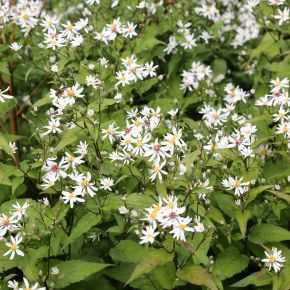Flower:
Daisy-like flowers are composted of slender white ray florets (petals) surrounding a central cluster of golden yellow disc florets that age to reddish-purple. The daisies are held in corymbs atop black, upright stems and are produced from July into October.
Flower colour: White
Flower shape: Daisy-like flowers, disc and ray florets held in corymbs
Flowering time: July, August, September, October
Foliage:
Mid to dark green leaves are ovate to lanceolate in shape with Cordate bases. The leaves gradually become smaller and more triangular higher up the stem. The leaves are Alternately arranged on nearly black, wiry stems and have Dentate margins.
Foliage Senescence: Deciduous
Foliage Shape: Ovate to lanceolate
Propagation:
Division, cuttings, seed.
Cultivation:
Best in full sun to partial shade in fertile, moisture-retentive soil that is well-drained.
